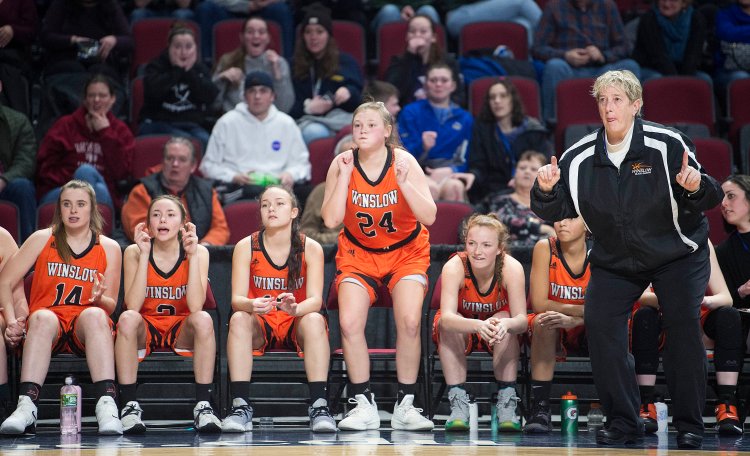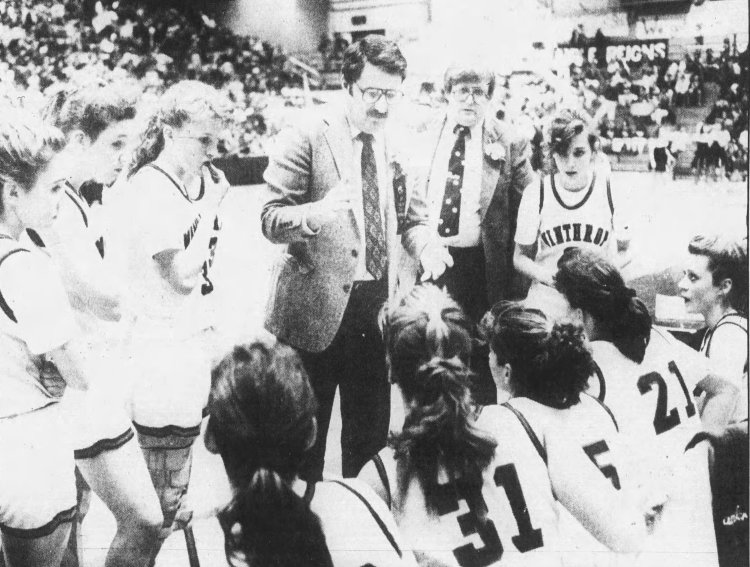
Our Communities. Our Teams. Our Future.
We’re proud to make high school sports coverage free for everyone—because these moments matter. At Maine State Credit Union, we’re here for the people and places that make Maine strong. Let’s Go! Learn more at mainestatecu.org.

In 1974, the Morse High girls basketball team finished with the best record in the Androscoggin Valley league and arranged a late exhibition game with Biddeford. The schools hailed it as an unofficial state championship, which Maine had never held. Morse showed up to the game wearing practice pinnies.
“It was a good game, but then it ended, and that was it,” said Darcy Emerson, a Morse sophomore that season. “No publicity or anything like that.”
The next year, for the first time, they got the real thing.
In 1975, Maine debuted its state girls basketball tournament, giving girls a chance to play for the same championships that boys had for over 50 years. Morse fell to Gardiner in the Class A title game, while Lake Region beat Van Buren in Class B. Hall-Dale beat Katahdin in triple overtime in Class C, and East Grand defeated Richmond in Class D.
The games came three years after the enactment of Title IX, the groundbreaking federal law that prohibits colleges that receive federal money from discriminating or excluding anyone based on their sex.
“I don’t think we were thinking about the groundbreaking (element) in ’75. We were caught up in it, and it was exciting and new,” Emerson said. “I think afterward … it was like ‘Oh, we were in the first state championship game.’ Only two teams get to say that. The pride in that is huge.”
The girls basketball tournament has since become a fixture in the state’s sports scene, and a source of memories that are still talked about decades later. It’s seen the rise of dominant players like Cindy Blodgett, Lisa Blais and Rachel Bouchard, as well as Emily Ellis, Sarah Marshall and Anna DeWolfe, who have pushed the profile of the sport in the state to new levels.

It ushered in juggernauts like Ed Feeney’s Portland Bulldogs, Paul Vachon’s Cony Rams and Liz Rickett’s McAuley Lions, who changed Maine fans’ perceptions of what the girls game can look like. It’s played out in front of packed arenas and raucous crowds.
And it’s given girls sports and its players, overlooked and starved for respect for years at local and national levels, their biggest audience — and their biggest stage on which to shine.
“Girls basketball has been at the forefront of Maine high school sports for girls, and it’s never been knocked off its throne,” said Brenda Beckwith, a former Lawrence High standout, longtime coach and Maine Basketball Hall of Famer.
“The weight of the women’s sports movement has been through girls basketball,” she added. “Teams are trying to rally and get volleyball teams or lacrosse teams, but basketball has been the reason why those sports have been able to flourish.”
Changing attitudes
Even into the 1970s, girls basketball struggled for the attention the boys game received. Rita (O’Connor) Maines, who scored more than 1,000 points before graduating from Brunswick in 1980, remembers having to practice in an old auditorium used more often for roller skating, while the boys team got to hold its practices in the school’s new gym.

The boys teams got to play in an exciting, highly publicized tournament, while girls teams saw their seasons end with league championships. Debra (Clark) Susi, a 1975 Gardiner High graduate, said she doesn’t remember thinking that was unfair — but she does remember asking why it was different.
“It was certainly a topic of conversation. And why wouldn’t it be?” she said. “I don’t know if we ever felt angry about it. We just sort of questioned why? We wanted someone to explain to us why it was a difference. If we’re all playing the same game under the same rules, why is it only this group of people that gets to go on and play? We love the game just as much.”
Even when the tournament was in place, girls basketball had yet to be fully embraced in Maine.
The inaugural championships were held in early February at smaller sites, while the boys played later in the month at the Bangor Auditorium, the state’s celebrated basketball venue. Girls tournament games were held during the day; boys games got night slots.
Beckwith, who is researching for a book on Maine girls basketball, said members of the state principals’ association were concerned fans wouldn’t turn out for later boys games if they had to sit through girls games first.
“Even in some of their comments … they said we’re going to be forced to do this, we might as well do this and get it out of the way,” Beckwith said. “That was kind of their attitude, that they were forced to do it because Title IX came.”
Gaining momentum
Girls basketball had decades earlier built up a tradition and fervent following in the northern and central parts of the state. In southern Maine, however, the interest was far cooler.
“When I first started coaching, it wasn’t popular at all,” said Ed Feeney, who coached the Portland girls from 1979 to 2007. “In northern Maine, basketball — both boys and girls — is a big part of their life. … We used to play in the Bangor Auditorium, it was a sellout. When we were in the state final and it was down here, Presque Isle would come down, they probably had more people than we did.”
Change, however, was coming. In 1978, freshman Lisa Blais (now Lisa Manning) emerged as a nationally recruited talent and led Westbrook to the first of four straight Class A championships, and status as Maine’s first dynasty.
In the mid-80s, Feeney’s Portland teams and Paul Vachon’s Cony girls teams started showcasing mirroring high-energy, up-tempo styles that obliterated the notion that girls basketball had to be a slower game.

“Once they started playing like boys, and playing hard and fast between the lines, interest went up,” said Feeney, who took the Bulldogs to 10 title games in 12 years between 1983-94 and won three championships. “There were no big crowds (early on). It started getting better once the game changed.”
Soon the girls tournament was a featured attraction, with star players throughout the classes and regions.
“There were some extraordinary players right at that time who just really made an impact on the game, really hallmark players who happened to arrive and drew the public attention,” said former Brunswick girls coach Fred Koerber, who led the Dragons from 1975-83. “They made the game more interesting because of their skills. For other players, that just gave them hallmarks to reach for.”
By the 1990s, a girls team at Lawrence, led by Blodgett, was the sports story of the state on its way to four straight titles. And in the two decades after the turn of the millennium, stars from McAuley, Deering, Gorham and Greely were leading the wave of players generating national collegiate interest.
“The word people used to use was ‘Isn’t that nice? Isn’t that nice that they’re playing?’ ” said Ray Convery, who coached the Winthrop girls from 1979-2003 and won the 1990 Class C championship. “To the point now where you hear them yelling ‘That’s a freaking foul!’ In other words, people are taking it that they’re out there performing like the boys are.
“It’s not just basketball. All (sports) are raised a level, people can now see what females are really capable of doing. … The tournament’s made it better for everybody. It’s made it more equal.”
A special opportunity
Lisa Manning remembers being the shy kid at Westbrook High. Then she’d take the court, and she’d transform.
“I don’t know where I’d be without sports, because you’d get me in a classroom and I would not say a word,” she said. “I felt like I could speak with my play on the floor. … The game starts, and I can’t stop yapping.”
For 50 years, the tournament has given the athletes who have played in it a chance to thrive under bright lights and in front of big crowds, and to rise to celebrity status in their communities.
“I remember at summer camps at McAuley, little girls coming up and saying they want to be like certain players on the team,” said Liz Rickett, who won two state championships and reached five title games while coaching at McAuley from 1998-2006. “They would wear socks, (do) their hair and mimic the girls.”
The tournament has given the thousands of players who have participated a chance to show the state — and themselves — what they can do. It’s an environment of pressure, nerves and expectation, and while some players naturally take to it, others grow into it.
“You’ll see seniors stepping up, knowing this is it for them,” Rickett said. “It’s an interesting environment, where you don’t know who’s going to step up and shine.”
The players who came first see that environment, and both how far along it has come, and how it has remained the same.
“We didn’t think we were breaking any barriers. We were just doing what we loved,” Susi said. “Yes, the playing ball is smaller. Some rules have changed. We have a 3-point line. The game’s faster.
“But the passion’s the same. That’s the thread that ties all our teams.”
